2. 国土资源部应用地球物理重点实验室, 长春 130026;
3. 油页岩地下原位转化与钻采技术国家地方联合工程实验室, 长春 130026;
4. 中国地质科学院地质研究所, 北京 100037;
5. 安徽省勘查技术院, 合肥 230031
2. Key Laboratory of Applied Geophysics, Ministry of Land and Resources, Changchun 130026, China;
3. National-Local Joint Engineering Laboratory of In-situ Conversion, Drilling and Exploitation Technology for Oil Shale, Changchun 130026, China;
4. Institute of Geology, Chinese Academy of Geological Science, Beijing 100037, China;
5. Institute of Geological Exploration Technology of Anhui Province, Hefei 230031, China
缝合带作为不同板块之间的构造边界,一般由含有残余洋壳的蛇绿岩混杂堆积和共生的深海相放射虫硅质岩、沉积岩等组成,叠加了蓝片岩相高度变质作用和强烈的构造变形(杨文采等,2004;许志琴,2007;Li et al., 2010;刘利双等,2015).缝合带两侧板块具有不同的性质和演化历史,通常是不同的生物地理区(周志广等,2010),并具有不同的古地磁要素(李朋武等, 2006, 2007).确定缝合带确切位置对恢复不同地史时期的板块构造格局以及研究板块聚散机制有着重要的科学意义.
古亚洲洋是一个东西向古大洋,产生于罗迪尼亚超大陆裂解时期,它长期存在于东欧—西伯利亚克拉通与塔里木—华北克拉通之间,洋内众多微陆块可能构成几条岛链(李三忠等,2016).西伯利亚板块南缘近东西向展布的大型高压变质带中蓝片岩指示古亚洲洋洋盆于650~520 Ma开始俯冲(徐公愉,1993),至二叠纪末期与华北克拉通碰撞形成世界上最宽阔、发展历史最长、构造岩浆活动最复杂的巨型增生造山带,即中亚造山带(Buchan,2001;Xiao et al.,2002,2003a, b, 2009; Xu et al.,2003b;Xiao,2004;朱永峰和徐新,2006;Windley et al.,2007;徐新等,2007;刘希军等,2009).由于中亚造山带记录了显生宙期间古亚洲洋俯冲闭合、陆陆汇聚及碰撞后伸展等地质过程,所以吸引了广大学者对其研究,识别出多条蛇绿岩带、蓝片岩带、金刚石及逆冲推覆构造等(Jian et al.,2008;Chen et al.,2009;Xu et al.,2013;李瑞彪等,2014),为确定古亚洲洋南缘闭合位置提供了线索.然而,受后期地质作用影响,至今对古亚洲洋南缘最终闭合位置仍存在争议:一种观点认为缝合线位于索伦山—贺根山一带(田昌烈等,1989;徐备和陈斌,1997);另一种观点认为沿西拉木伦河断裂带一线(Wu et al.,2002);还有学者认为位于贺根山以南、林西以北的宽阔带(陈斌等,2001;Xiao et al.,2003).在过去的研究中,主要以岩石学、地层学、生物古地理、地球化学和年代学研究手段,采用的深部样品的分布具有局限性和不均匀性,严重制约了从整体上对问题的认识,少数以地球物理方法仅对地壳结构进行了初步约束(徐新学等,2011;梁宏达等,2015;董泽义等,2016),未能揭示此碰撞-拼合区整个岩石圈内部结构,致使古亚洲洋最终闭合位置仍然认识不清,在一定程度上制约了Pangea超大陆东亚陆块重建.因此,本文基于大地电磁测深及人工反射地震所揭示的深部结构,结合前人研究成果(Li et al., 2016;Liu et al., 2016;Zhang and Zhang, 2017),对西伯利亚板块与华北克拉通碰撞带缝合带位置这一关键地质问题进行了探索与研究.
1 缝合带蛇绿岩被认为是保存在陆(或弧)上的大洋岩石圈残片(白文吉等,1995;Dilek and Furnes, 2011;马冲,2011;Khain et al.,2003),是判别洋-陆俯冲到陆-陆碰撞后所留缝合带存在的重要标志.华北克拉通与西伯利亚克拉通南部碰撞拼合带是由南蒙活动大陆边缘、二连—贺根山增生杂岩带、宝力岛弧、二道井子增生杂岩带、温都尔庙增生杂岩带和白乃庙岛弧组成的复杂碰撞-拼合体系(图 1),内部发育索伦—西拉木伦河蛇绿岩带和二连—贺根山蛇绿岩带两条主要的蛇绿岩带.二连浩特—贺根山蛇绿岩带从二连浩特东侧的萨达格勒庙、阿尔登格勒庙向东北经贺根山至窝棚特一带,断续延伸约400 km,从西向东断续出露多个蛇绿岩块:二连浩特蛇绿岩、朝克山蛇绿岩、贺根山蛇绿岩、松根乌拉山蛇绿岩、乌斯尼黑蛇绿岩,主要岩性为方辉橄榄岩、二辉橄榄岩、层状和块状辉长岩、辉绿岩墙(脉)、基性熔岩、枕状玄武岩、辉斑玄武岩、及硅质岩等(王树庆等,2008).二连浩特辉绿岩墙和侵入到蛇绿岩中的花岗闪长岩岩墙的锆石U-Pb年龄,分别为295±9 Ma和244±4 Ma(Miao et al.,2008).贺根山蛇绿岩中辉长闪长岩(341±3 Ma)和玄武岩(359±5 Ma)结晶年龄为早石炭世早期,同时玄武岩继承锆石峰值年龄为晚泥盆世早期(375±2 Ma)(黄波等,2016).硅质岩中的晚泥盆世古生物化石(刘家义,1985;郑萍等,2008),指示了该区域晚古生代早期为大洋环境.最近在二连浩特艾力格庙地区和苏尼特左旗以南地区的混杂岩带内发现了以岩块形式出现的蓝片岩,等时线年龄为383±13 Ma(徐备等,2001;李瑞彪等,2014),又在贺根山蛇绿岩的铬铁矿中发现金刚石等深部地幔矿物(黄竺等,2015),证明了该蛇绿岩带为大洋沉积物俯冲到上地幔折返的产物(蔡志慧等,2009).梅劳特乌拉块状辉长岩的U-Pb锆石年龄为308.5±22 Ma,据此确定梅劳特乌拉蛇绿岩形成于晚石炭世(李英杰等,2015).上述锆石年龄资料,将贺根山蛇绿岩带的形成时间限定在晚泥盆世—晚石炭世早期,即二连浩特—贺根山蛇绿岩带为西伯利亚板块与华北克拉通碰撞带内晚泥盆世—晚石炭世早期形成的缝合带.穿过贺根山地区的倾向南、北的一个逆冲体系(图 2,Xiao et al.,2003).

|
图 1 研究区地质图(据全国1:250万地质图修) Fig. 1 Geological map of the study area(after the national 1:2.5 million geological map repaired) |
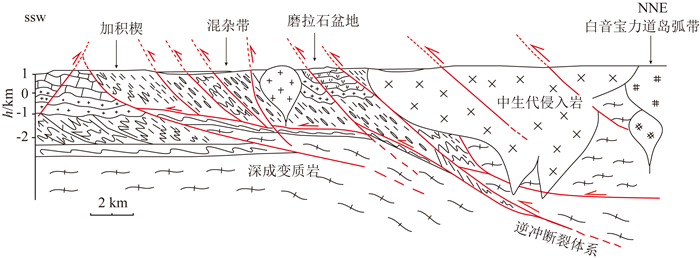
|
图 2 二连—贺根山缝合带构造剖面(据Xu et al,2013) Fig. 2 Tectonic profile along the Erlian-Hengenshan suture zone (after Xu et al, 2013) |
索伦—西拉木伦河蛇绿岩带自西向东主要由索伦山蛇绿岩、温都尔庙蛇绿岩和柯单山蛇绿岩等组成,主要岩性为蛇纹石化橄榄岩、蛇纹石化辉石橄榄岩、辉长辉绿岩、枕状熔岩、玄武岩、硅质岩等组成(胡骁等,1987;梅盛旺等,2016).满都拉西部出露的蛇绿混杂岩中橄榄辉长岩的单颗粒锆石U-Pb年龄为385.6±1.7 Ma,显示该蛇绿岩形成于早泥盆世晚期(白立兵等,2004).柯单山蛇绿岩中辉长岩岩脉的锆石定年结果也为中二叠世281.0±6.4 Ma.九井子蛇绿岩中辉长岩的形成时代为274.7±1.7 Ma,属于早二叠世晚期(刘建峰等,2016),这些锆石年龄表明索伦—西拉木伦河地区在中二叠世依然处于海洋环境,蛇绿岩带内硅质岩中存在的化石和古地磁研究结果进一步证明了这一观点(胡晓等,1987;王惠等,2005;Wang et al.,2005;李朋武等,2006;Shi and Chen, 2006;Deng et al.,2009).同时古地理研究显示直到晚二叠世才出现陆相沉积地层(和政军等,1997;Zhang S B et al.,2014;Zhang S H et al.,2014),指示索伦—西拉木伦河蛇绿构造混杂岩带自西向东逐步缝合,最终混杂堆积的时间为晚二叠世—早三叠世.
综上所述,在西伯利亚板块与华北克拉通碰撞带存在两条不同时期形成的缝合带,预示着该区域岩石圈存在两大汇聚体系的构造形迹.
2 研究方法 2.1 大地电磁测深数据采集大地电磁测深剖面位于西伯利亚板块与华北克拉通南缘碰撞带,隶属于中亚造山带东南部(图 1).整条剖面近南北向展布,西起中蒙边界,途径查干敖包、二连浩特、苏尼特右旗、温都尔庙,向南至化德县,自北向南穿过了南蒙活动大陆边缘、二连—贺根山增生杂岩带、宝力岛弧、二道井子增生杂岩带、温都尔庙增生杂岩带和白乃庙岛弧次级构造单元.大地电磁测深剖面全长约410 km,宽频大地电磁测深数据基本点距5 km,共完成79个物理点,长周期大地电磁数据基本点距约为20 km,共完成15个物理点,测点位置与对应宽频大地电磁测深点位重合.野外资料采集都使用加拿大MTU-5A和乌克兰Lemi-417型大地电磁测深仪,数据采集过程中采用张量测量方式布极,每个测点测量3个磁场分量和2个相互正交的水平电场分量.大地电磁测深点采集过程中使用GPS同步观测,宽频采集时间约为20 h,长周期采集时间在120~170 h之间.
2.2 数据处理与分析在数据处理过程中,首先对原始时间序列数据进行快速傅里叶变换,将时间域信号转变为频率域数据,并通过远参考技术、“Robust”估计(Egbert,1997)、功率谱挑选和静位移矫正等处理技术,获得较高质量的阻抗张量信息.经过一系列处理后,最终得到剖面所有测点的视电阻率与相位曲线,宽频获得320~0.0005 Hz有效数据,长周期获得20~20000 s有效数据.对获得的两种数据在同一坐标系下进行绘图,其中小于320~0.0005 Hz频段用宽频数据进行绘图,小于0.0005 Hz频段用长周期数据,拼接频段的曲线形态与趋势基本一致(图 3).视电阻率和阻抗相位曲线可以反映地下介质的电性分布特征,如构造分区、电性分层等,研究区的典型视电阻率和阻抗相位曲线,其中334号点位于南蒙活动大陆边缘,324号位于二连—贺根山增生杂岩带;292和284号点位于宝力岛弧;252位于二道井子增生杂岩带;232号位于白乃庙岛弧.从各个构造单元内部典型原始曲线可以看出,不同地质单元的电性结构具有明显的差异.
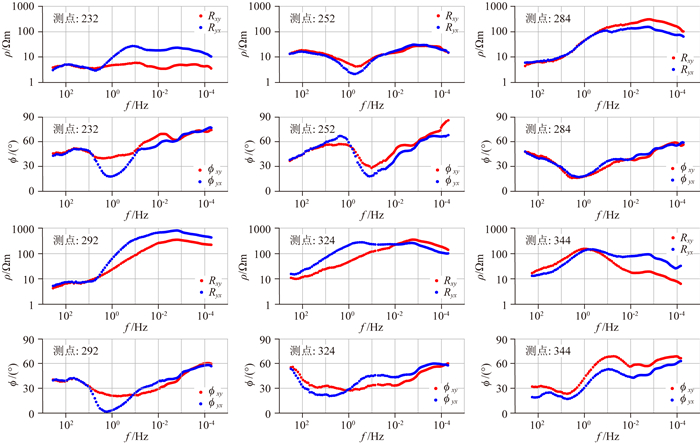
|
图 3 部分测点视电阻率和相位曲线图 Fig. 3 Apparent resistivity and phase curves of partial measurement sites |
维性与构造走向分析是大地电磁测深数据反演的前提(蔡军涛等,2010;陈小斌和郭春玲,2017).研究区主干断裂主要为NEE向构造展布,整体上具备二维特征.本文运用基于GB张量阻抗分解技术(Groom and Bailey, 1989;Mcneice and Jones, 2012)对研究区维性特征与区域构造走向进行分析.图 4给出了剖面全部测点GB分解获得的二维偏离度随频率变化图,可见剖面二维偏离度普遍小于0.2,在局部位置低频段二维偏离度大于0.3,说明了剖面主体部分具有明确的二维特征,该特征为本文的二维反演工作奠定了基础.图 5给出了剖面在不同地质构造单元上的相位张量分解确定的电性主轴玫瑰图(Smith and Booker, 1991;魏文博等,2008),长轴指示电性主轴方向,但由于电性走向存在90°的不确定性,结合区域构造走向特征,剖面南段化德—苏尼特右旗主轴判断为东西向0°,苏尼特右旗—二连浩特段主轴判断为北东45°.因此,化德—苏尼特右旗阻抗未旋转,ρxy和φxy数据为TM极化模式,ρyx和φyx数据为TE极化模式.苏尼特右旗—二连浩特阻抗旋转45°后,ρyx和φyx数据为TM极化模式, ρxy和φxy数据为TE极化模式.

|
图 4 二维偏离度拟断面图 Fig. 4 Pseudo-cross section of two-dimensional deviation degrees |
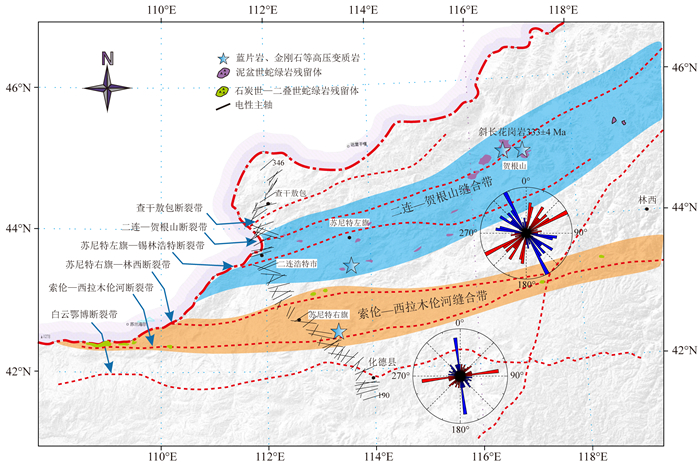
|
图 5 电性主轴及其统计结果玫瑰图(0.041 Hz) Fig. 5 Rose diagram of electrical principal axes and statistics(0.041 Hz) |
数据反演基于非线性共轭梯度(NLCG,Rodi and Mackie, 2000)二维反演算法,对TE+TM模式进行联合反演.从维性分析可知研究区深部存在一定三维结构,数值模拟结果显示TE模式的视电阻率数据容易受到三维畸变效应影响(蔡军涛和陈小斌,2010),因此本文对剖面反演时,增大TE模式视电阻率的本底误差,以减小TE模式数据对整体反演结果的影响(许林斌等,2017).另外,选用不同的正则化因子τ值进行反演,以各个模型的粗糙度(Roughness)为横轴,均方根误差(RMS)为纵轴做L曲线图(如图 6所示),处于曲线拐点处对应的τ值,既兼顾了模型的光滑程度,又与原始数据有很好的拟合关系(Farquharson and Oldenburg, 2004;Hu et al., 2015),因此选择拐点处对应值10作为模型的τ值.

|
图 6 剖面不同正则化因子反演得到的模型粗糙度与拟合差曲线 Fig. 6 Model roughness and fitting difference curve from inversion with different regularization factors |
反演初始模型为100 Ωm均匀半空间,网格剖分大小为200×100,选择对TM模式视电阻率和阻抗相位分别使用20%和10%的本底误差,而TE模式的视电阻率和阻抗相位分别使用50%和50%的本底误差,正则化因子τ=10,横纵光滑比为1.经过300次迭代计算,RMS反演拟合差为2.29.实测数据与拟合数据基本一致(图 7,图 8),指示反演获得的电性结构是可以接受的.

|
图 7 剖面实测数据频率与视电阻率、相位拟断面图 Fig. 7 Profiles of measured frequency and apparent resistivity and pseudo-cross section of phase |

|
图 8 剖面响应数据频率与视电阻率、相位拟断面图 Fig. 8 Profile of frequency and apparent resistivity from response and pseudo-cross section of phase |
中亚造山带地壳厚度在40 km左右,靠近华北克拉通北缘有小幅增厚趋势.根据电性结构及人工地震反射剖面,西伯利亚板块与华北克拉通南缘碰撞带大致可分为三个电性区域.
查干敖包断裂带以北的南蒙活动大陆边缘为第一电性区,浅层局部表现为中、低电阻率,对应南倾地震反射界面,为中生代控盆构造及其内部沉积物,而浅部高阻异常与地震剖面的漫散射特征相对应,推测为地表出露的古生代花岗岩.中、下地壳呈现“两高夹一低”的电性特征,对应一系列北倾及弧形反射界面,推测为地体碰撞的过程中韧性下地壳滑动所留构造痕迹和底侵的玄武质岩深部玄武岩床反映.
查干敖包断裂带与索伦—西拉木伦河断裂带之间为第二电性区,包括二连贺根山增生杂岩带、宝力岛弧、二道井增生杂岩带和温都尔庙增生杂岩带.地表主要出露古生界、中生界及增生杂岩等,电性上表
现为中、低阻异常,下伏高阻块体为花岗质岩隐伏岩体,并在二连浩特北地区出露.在二连浩特和苏尼特右旗深部15 km左右出现弧形反射体,对应区域下地壳出现一系列对冲弧形反射界面(AR1和AR2),AR1弧形反射体表现为高阻异常,表征了洋壳物质俯冲到地幔之后折返的痕迹,可能为东北部地表出露蛇绿岩体深部的隐伏部分.弧形反射体两侧为电性梯度带,推测可能存在断裂构造.AR2弧形反射体则呈现低阻异常,弧形反射体北侧为电性梯度带,南侧则与大型倾斜反射体相连,推测为碰撞前缘所形成的堆积楔.第二电性区中、下地壳由C2、C3、C4和C5低阻异常体组成,电阻率值基本小于40 Ωm,C2和C3低阻异常对应层状反射体,推测为具有一定流变性的玄武岩.C4低阻异常体厚度最大,对应“鳄鱼嘴”状反射体,推测是与碰撞有关的增生杂岩体.C5低阻异常体北倾狭长状,该异常起于温都尔庙南部,止于苏尼特右旗中、下地壳,自南向北埋藏深度逐渐变深,地震剖面上表现为大型倾斜反射面,推测为西拉木伦河逆冲断裂带.
西拉木伦河断裂带以南的白乃庙岛弧为第三电性区,浅地表呈现高低相间的电性特征,地表对应出露古生界和花岗岩.中、下地壳出现主体以表现为高阻特征,电阻率值在1000 Ωm以上,人工反射剖面同样显示一系列北倾反射界面(OR),推测高阻、层状反射异常可能是片麻岩的反映(图 9).
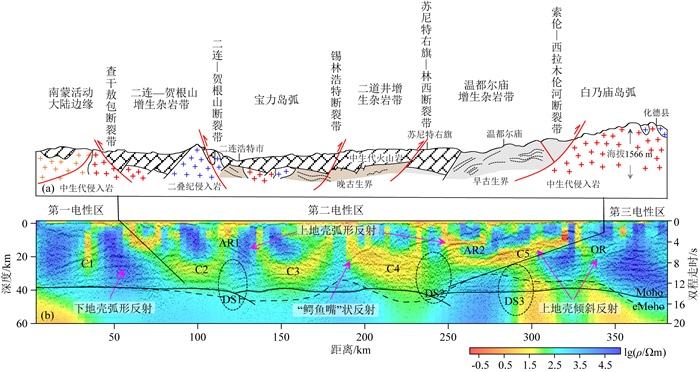
|
图 9 (a) 地质剖面图;(b)大地电磁测深二维电性结构与人工反射地震剖面叠合图(地震剖面据Zhang et al.,2014) 其中C1、C2、C3、C4和C5代表低阻异常体,AR1和AR2代表上地壳弧形反射;DS1、DS2和DS3表示电性梯度带. Fig. 9 (a) Geological cross section; (b) Superposed magnetotelluric two-dimensional electrical structure and artificial reflection seismic profile (seismic profile from Zhang et al., 2010) C1 to C5 represent low-resistivity anomaly bodies. AR1 and AR2 represent the upper crust arc-like reflection; DS1, DS2 and DS3 represent the electric gradient zones. |
莫霍面(Moho)被认为是由玄武岩或辉长岩到榴辉岩的相变带,或是把长石含量高的地壳岩石同下面的纯橄榄岩或橄榄岩分隔开的岩性界面.在人工地震反射揭示,莫霍面在双程走时约13~14 s深度处,呈现下地壳强反射区和相对应的透明地幔之间的界限,且连续性好.若按照地壳平均P波速率约6.4 km·s-1(Zheng et al.,2007)计算,莫霍面埋深在41~45 km之间.但在构造复杂的造山带,不同地质单元之间用地壳平均速度所计算出的莫霍面深度会存在较大误差,故结合电性分界面所勾勒的莫霍面形态更能反映客观事实.在深部电性结构上,电性莫霍面表现为明显的电性分界限(eMoho),埋深变化相对较大.在温都尔庙以北地区表现为高阻异常,上部由C1~C5构成的中、低阻异常层,下部为高阻的岩石圈地幔,而在温都尔庙至化德县之间地壳表现高阻特征,岩石圈地幔则表现低阻异常.总体而言,电性莫霍面与人工反射地震所确定的莫霍面基本一致,北部平缓,南部变化相对剧烈.
3.2 岩石圈地幔兴蒙造山带岩石圈地幔电性结构呈现“三高一低”的格局(图 10),反映了岩石圈地幔厚度变化大,整体呈现两边厚中间薄的特征.南蒙大陆边缘活动带、二连—贺根山增生杂岩带岩石圈地幔电阻率呈现高阻块体(R1),电阻率在1000 Ωm,厚度从北侧110 km迅速减薄至40 km.宝力道岛弧、二道井增生杂岩带岩石圈同样呈现高阻块体(R2),电阻率值在800~1000 Ωm之间,厚度从40 km又递增到50 km左右.温都尔庙增生杂岩带岩石圈电阻率最高(R3),电阻率值大于1000 Ωm,厚度也迅速增加到90 km,指示了刚性碰撞前缘的特征.白乃庙岛弧岩石圈地幔则呈现低阻块体(C6),电阻率值小于100 Ωm,厚度也稳定在90 km.另外,岩石圈地幔内部存在三条电性梯度带(DS1、DS2和DS3),其中DS1电性梯度带表现较弱,位于二连—贺根山缝合带附近,DS2电性梯度带表现相对较强,位于索伦—林西断裂带附近,人工地震反射剖面上,上述两区域地壳呈现明显的汇聚特征(AR1和AR2),深部这一电性特征进一步指示了两处为深部缝合位置.DS3位于索伦—西拉木伦河断裂带附近,但在人工反射剖面上,地壳未呈现汇聚特征,而是呈现一系列北倾反射界面(OR),表明此处不是深部缝合带.
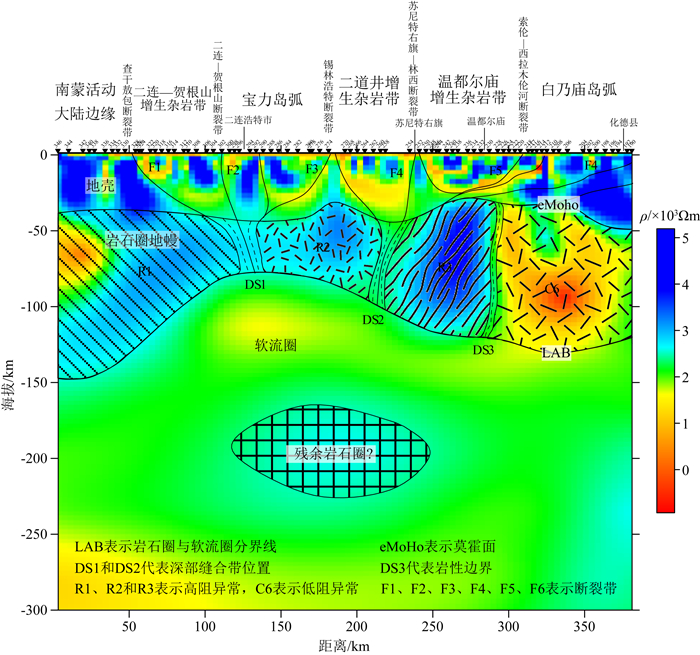
|
图 10 二维电性结构剖面及其解释图 Fig. 10 Two-dimensional electrical structure profile and its interpretation |
层析成像研究结果显示,本区软流圈顶界面在80~150 km之间变化,底界面基本稳定在300 km深度处(袁学诚,2007).而在电性结构上软流圈呈现低阻特征,电阻率基本小于100 Ωm(图 10),一般认为是橄榄岩经部分熔融的所致.软流圈顶界面(LAB)整体呈现不对称的优弧型,即北部南蒙活动大陆边缘和南部白乃庙岛弧软流圈顶界面埋深分别为150 km、125 km左右,而二连—贺根山增生杂岩带与宝力岛弧一带为软流圈上涌区,顶界面埋深约为80 km,其下方存在约400 Ωm的中阻异常,为软流圈内部最显著的特征.中亚造山带主体表现为“多增生楔—多期次—多方向—多方式”的增生造山(Xiao et al., 2015),经历了多期次洋壳俯冲、消减及碰撞拼贴过程,因此软流圈内部高阻异常可能为俯冲消失的洋壳或碰撞造山后拆离的岩石圈残片.另外,二连盆地群是发育在两大汇聚体系之上的中生代断陷盆地,又处于软流圈上涌区域,指示了该NE向盆地群的形成与碰撞拼合后的伸展作用有关.
4 结论通过对西伯利亚板块与华北克拉通碰撞带地电结构及人工反射地震结构研究主要获得以下认识:西伯利亚板块与华北克拉通碰撞带地壳存在多组“U”型低阻异常,多对应弧型、倾斜或“鳄鱼嘴”状反射界面,岩石圈地幔除白乃庙岛弧呈低阻块体外,均为高阻块体,这些物性结构特征反映了西伯利亚板块与华北克拉通南北汇聚所形成的构造形迹.碰撞带可分为二连—贺根山和索伦—西拉木伦河两个不同时期的汇聚体系,晚泥盆世—晚石炭世早期形成的二连—贺根山汇聚体系由二连—贺根山增生杂岩带、宝力岛弧地体及断裂带组成,深部缝合边界位于二连浩特.而晚二叠—早三叠的索伦—西拉木伦河汇聚体系由二道井子增生杂岩带和温都尔庙增生杂岩带地体及断裂带组成,深部缝合边界位于苏尼特右旗.在锡林浩特地区软流圈内部存在高阻异常,可能为俯冲消失的洋壳或碰撞造山后拆离的岩石圈残片.
Bai L B, Li Y X, Liu J J. 2004. Characteristics and tectonic settings of the Devonian basic volcanic rocks in Mandula, inner Mongolia. Geology and Mineral Resources of South China (in Chinese), (3): 50-54. |
Bai W J, Yang J S, Zhou M F, et al. 1995. Tectonic evolution of different dating ophiolites in the western Junggar, Xinjiang. Acta Petrologica Sinica (in Chinese), 11(S1): 62-72. |
Buchan C A. 2001. Tectonic evolution of the Bayankhongor Ophiolite, Central Mongolia: Implications for the Palaeozoic crustal growth of Central Asia. Leicester: University of Leicester.
|
Cai J T, Chen X B. 2010. Refined techniques for data processing and two-dimensional inversion in magnetotelluric Ⅱ:Which data polarization mode should be used in 2D inversion. Chinese Journal of Geophysics (in Chinese), 53(11): 2703-2714. DOI:10.3969/j.issn.0001-5733.2010.11.018 |
Cai J T, Chen X B, Zhao G Z. 2010. Refined techniques for data processing and two-dimensional inversion in magnetotelluric Ⅰ:Tensor decomposition and dimensionality analysis. Chinese Journal of Geophysics (in Chinese), 53(10): 2516-2526. DOI:10.3969/j.issn.0001-5733.2010.10.025 |
Cai Z H, Xu Z Q, Tang Z M, et al. 2009. Exhumation kinetics of northern Sulu ultrahigh-pressure metamorphic belt, Rongcheng Area. Acta Petrologica Sinica (in Chinese), 25(7): 1627-1638. |
Chen B, Jahn B M, Tian W. 2009. Evolution of the Solonker suture zone:Constraints from zircon U-Pb ages, Hf isotopic ratios and whole-rock Nd-Sr isotope compositions of subduction-and collision-related magmas and forearc sediments. Journal of Asian Earth Sciences, 34(3): 245-257. DOI:10.1016/j.jseaes.2008.05.007 |
Chen B, Zhao G C, Wilde S. 2001. Subduction-and Collision-related granitoids from southern Sonidzuoqi, inner Mongolia:Isotopic ages and tectonic implications. Geological Review (in Chinese), 47(4): 361-367. |
Chen X B, Guo C L. 2017. Refined techniques for data processing and two-dimensional inversion in magnetotelluric (Ⅴ):Detecting the linear structures of the Earth by impedance tensor imaging. Chinese Journal of Geophysics (in Chinese), 60(2): 766-777. DOI:10.6038/cjg20170227 |
Deng S H, Wan C B, Yang J G. 2007. Discovery of a Late Permian Angara-Cathaysia mixed flora from Acheng of Heilongjiang, China, with discussions on the closure of the Paleoasian Ocean. Science in China Series D: Earth Sciences, 52(11): 1746-1755. |
Dilek Y, Furnes H. 2011. Ophiolite genesis and global tectonics:Geochemical and tectonic fingerprinting of ancient oceanic lithosphere. GSA Bulletin, 123(3-4): 387-411. DOI:10.1130/B30446.1 |
Dong Z Y, Tang J, Chen X B, et al. 2016. Deep electric structure beneath northeastern boundary areas of the North China craton. Seismology and Geology (in Chinese), 38(1): 107-120. |
Egbert G D. 1997. Robust multiple-station magnetotelluric data processing. Geophysical Journal International, 130(2): 475-496. DOI:10.1111/gji.1997.130.issue-2 |
Farquharson C G, Oldenburg D W. 2004. A comparison of automatic techniques for estimating the Regularisation parameter in non-linear inverse problems. Geophysical Journal International, 156(3): 411-425. DOI:10.1111/gji.2004.156.issue-3 |
Groom R W, Bailey R C. 1989. Decomposition of magnetotelluric impedance tensors in the presence of local three-dimensional galvanic distortion. Journal of Geophysical Research: Solid Earth, 94(B2): 1913-1925. DOI:10.1029/JB094iB02p01913 |
He Z J, Liu S W, Ren J S, et al. 1997. Late Permian-early Triassic sedimentary evolution and tectonic setting of the Linxi region. Regional Geology of China (in Chinese), 16(4): 403-409, 427. |
Hu X, Niu S Y, Zhang Y T. 1987. The middle-late Silurian flysch in the Bainaimiao area, Nei Monggol. Regional Geology of China (in Chinese), (4): 47-54. |
Hu Y C, Li T L, Fan C S, et al. 2015. Three-dimensional tensor controlled-source electromagnetic modeling based on the vector finite-element method. Applied Geophysics, 12(1): 35-46. DOI:10.1007/s11770-014-0469-1 |
Huang B, Fu D, Li S C, et al. 2016. The age and tectonic implications of the Hegenshan ophiolite in Inner Mongolia. Acta Petrologica Sinica (in Chinese), 32(1): 158-176. |
Huang Z, Yang J S, Zhu Y W, et al. 2015. The discovery of diamonds and deep mantle minerals in chromitites of Hegenshan ophiolite, Inner Mongolia. Geology in China (in Chinese), 42(5): 1493-1514. |
Jian P, Liu D Y, Kröner A, et al. 2008. Time scale of an early to mid-Paleozoic orogenic cycle of the long-lived Central Asian Orogenic Belt, Inner Mongolia of China:Implications for continental growth. Lithos, 101(3-4): 233-259. DOI:10.1016/j.lithos.2007.07.005 |
Khain E V, Bibikova E V, Salnikova E B, et al. 2003. The Palaeo-Asian ocean in the Neoproterozoic and early Palaeozoic:new geochronologic data and palaeotectonic reconstructions. Precambrian Research, 122(1-4): 329-358. DOI:10.1016/S0301-9268(02)00218-8 |
Li L, Sun F Y, Li B L, et al. 2016. Early Mesozoic southward subduction of the eastern Mongol-Okhotsk oceanic plate:evidence from zircon U-Pb-Hf isotopes and whole-rock geochemistry of Triassic granitic rocks in the Mohe Area, NE China. Resource Geology, 66(4): 386-403. DOI:10.1111/rge.2016.66.issue-4 |
Li P W, Gao R, Guan Y, et al. 2006. Palaeomagnetic constraints on the final closure time of Solonker-Linxi suture. Journal of Jilin University (Earth Science Edition) (in Chinese), 36(5): 744-758. |
Li P W, Gao R, Guan Y, et al. 2007. Paleomagnetic constraints on the collision of Siberian and north china blocks, with a discussion on the tectonic origin of the ultrahigh-pressure metamorphism in the Sulu-Dabie region. Acta Geoscientica Sinica (in Chinese), 28(3): 234-252. |
Li R B, Xu B, Zhao P, et al. 2014. The discovery of blueschist-facies rock in Airgin Sum area, Erenhot, Inner Mongolia and its tectonic significance. Chinese Science Bulletin (in Chinese), 59(1): 66-71. |
Li S Z, Zhao S J, Yu S, et al. 2016. Proto-Tehtys Ocean in East Asia (Ⅱ):Affinity and assmbly of Early Paleozoic micro-continental blocks. Acta Petrologica Sinica (in Chinese), 32(9): 2628-2644. |
Li X P, Zhang L F, Wilde S A, et al. 2010. Zircons from rodingite in the Western Tianshan serpentinite complex:Mineral chemistry and U-Pb ages define nature and timing of rodingitization. Lithos, 118(1-2): 17-34. DOI:10.1016/j.lithos.2010.03.009 |
Li Y J, Wang J F, Li H Y, et al. 2015. Recognition of Meilaotewula ophiolite in Xi U Jimqin Banner, Inner Mongolia. Acta Petrologica Sinica (in Chinese), 31(5): 1461-1470. |
Liang H D, Gao R, Hou H S, et al. 2015. Post-collisional extend record at crustal scale:Revealed by the deep electrical structure from the southern margin of the central Asian orogenic belt to the northern margin of the North China Craton. Chinese Journal of Geology (in Chinese), 50(2): 643-652. |
Liu J F, Li J Y, Sun L X, et al. 2016. Zircon U-Pb dating of the Jiujingzi ophiolite in Bairin Left Banner, Inner Mongolia:Constraints on the formation and evolution of the Xar Moron River suture zone. Geology in China (in Chinese), 43(6): 1947-1962. |
Liu J Y, Li C Y, Xiao X C. 1985. Study on ophiolite suite and its tectonic significance in the inner Mongolian hegen mountain area . Proceedings of the Chinese Academy of Geological Sciences (in Chinese): 176-177. |
Liu L S, Liu F L, Liu P H, et al. 2015. Geochemical characteristics and metamorphic evolution of meta-mafic rocks from Haiyangsuo area, Sulu ultrahigh-pressure metamorphic belt. Acta Petrologica Sinica (in Chinese), 31(10): 2863-2888. |
Liu R C, Jiang Y J, Li B. 2016. Effects of intersection and dead-end of fractures on nonlinear flow and particle transport in rock fracture networks. Geosciences Journal, 20(3): 415-426. DOI:10.1007/s12303-015-0057-7 |
Liu X J, Xu J F, Wang S Q, et al. 2009. Geochemistry and dating of E-MORB type mafic rocks from Dalabute ophiolite in West Junggar, Xinjiang and geological implications. Acta Petrologica Sinica (in Chinese), 25(6): 1373-1389. |
Ma C, Zhao G P, Xiao W J, et al. 2011. Emplacement of ophiolites:Mechanisms and timing. Chinese Journal of Geology (in Chinese), 46(3): 865-874. |
McNeice G W, Jones A G. 2012. Multisite, multifrequency tensor decomposition of magnetotelluric data. Geophysics, 66(1): 158-173. |
Mei S W, Wang Y M, Du X F, et al. 2016. Geochemical characteristics of the serpentinized peridotite in the Wenduermiao Area, Inner Mongolia, China and their geological significance. Bulletin of Mineralogy, Petrology and Geochemistry (in Chinese), 35(2): 212-221. |
Miao L C, Fan W M, Liu D Y, et al. 2008. Geochronology and geochemistry of the Hegenshan ophiolitic complex:Implications for late-stage tectonic evolution of the Inner Mongolia-Daxinganling Orogenic Belt, China. Journal of Asian Earth Sciences, 32(5-6): 348-370. DOI:10.1016/j.jseaes.2007.11.005 |
Rodi W, Mackie R L. 2000. Nonlinear conjugate gradients algorithm for 2-D magnetotelluric inversion. Geophysics, 66(1): 174-187. |
Shi G R, Chen Z Q. 2006. Lower Permian oncolites from South China:Implications for equatorial sea-level responses to Late Palaeozoic Gondwanan glaciation. Journal of Asian Earth Sciences, 26(3-4): 424-436. DOI:10.1016/j.jseaes.2005.10.009 |
Smith J T, Booker J R. 2012. Rapid inversion of two-and three-dimensional magnetotelluric data. Journal of Geophysical Research: Solid Earth, 96(B3): 3905-3922. |
Tian C L, Cao C Z, Yang F L. 1989. Geochemical features of ophiolite in the fold belt on the north side of the Sino-Korean platform. Bulletin of the Chinese Academy of Geological Science (in Chinese), 11: 107-129. |
Wang H, Wang Y J, Chen Z Y, et al. 2005. Discovery of the Permian radiolarians from the Bayanaobao area, Inner Mongolia. Journal of Stratigraphy (in Chinese), 29(4): 368-371. |
Wang S Q, Xu J F, Liu X J, et al. 2008. Geochemistry of the Chaokeshan ophiolite:Product of intra-oceanic back-arc basin?. Acta Petrologica Sinica (in Chinese), 24(12): 2869-2879. |
Windley B F, Alexeiev D, Xiao W J, et al. 2007. Tectonic models for accretion of the Central Asian Orogenic Belt. Journal of the Geological Society, 164: 31-47. DOI:10.1144/0016-76492006-022 |
Wu F Y, Sun D Y, Li H M, et al. 2002. A-type granites in northeastern China:Age and geochemical constraints on their petrogenesis. Chemical Geology, 187(1-2): 143-173. DOI:10.1016/S0009-2541(02)00018-9 |
Xiao W J. 2004. Paleozoic accretionary and collisional tectonics of the eastern Tianshan(China):Implications for the continental growth of central Asia. Social Compass, 304(1): 85-98. |
Xiao W J, Brian F, Windley, et al. 2002. Arc-ophiolite obduction in the Western Kunlun Range (China):Implications for the Palaeozoic evolution of Central Asia. J Geol Soc Lond. Journal of the Geological Society, 159(13): 517-528. |
Xiao W J, Brian F. Windley, Hao J, et al. 2003. Accretion leading to collision and the Permian Solonker suture, Inner Mongolia, China:Termination of the central Asian orogenic belt. Tectonics, 22(6): 8-1-8-20. |
Xiao W J, Windley B F, Huang B C, et al. 2009. End-Permian to mid-Triassic termination of the accretionary processes of the southern Altaids:Implications for the geodynamic evolution, Phanerozoic continental growth, and metallogeny of Central Asia. International Journal of Earth Sciences, 98(6): 1189-1217. DOI:10.1007/s00531-008-0407-z |
Xiao W J, Windley B F, Sun S, et al. 2015. A tale of amalgamation of three permo-triassic collage systems in Central Asia:Oroclines, Sutures, and Terminal Accretion. Annual Review of Earth and Planetary Sciences, 43(1): 477-507. DOI:10.1146/annurev-earth-060614-105254 |
Xu B, Charvet J, Chen Y, et al. 2013. Middle Paleozoic convergent orogenic belts in western Inner Mongolia (China):framework, kinematics, geochronology and implications for tectonic evolution of the Central Asian Orogenic Belt. Gondwana Research, 23(4): 1342-1364. DOI:10.1016/j.gr.2012.05.015 |
Xu B, Charvet J, Zhang F Q. 2001. Primary study on petrology and geochrononology of blueschists in Sunitezuoqi, Northern Inner Mongolia. Chinese Journal of Geology (in Chinese), 36(4): 424-434. |
Xu B, Chen B. 1997. Framework and evolution of the middle Paleozoic orogenic belt between Siberian and North China Plates in northern Inner Mongolia. Science in China Series D: Earth Sciences, 40(5): 463-469. |
Xu G Y. 1993. The tectonic evolution of Paleo-Asian Ocean in Northeast Asia. Jilin Geology (in Chinese), 12(3): 1-8. |
Xu L B, Wei W B, Jin S, et al. 2017. Study of deep electrical structure along a profile from northern Ordos block to Yinshan orogenic belt. Chinese Journal of Geophysics (in Chinese), 60(2): 575-584. DOI:10.6038/cjg20170212 |
Xu X, Zhu Y F, Chen B. 2007. Petrology of the Kamste ophiolite mélange from East Junggar, Xinjiang, NW China. Acta Petrologica Sinica (in Chinese), 23(7): 1603-1610. |
Xu X X, Li J J, Liu J C, et al. 2011. The crust-upper mantle electrical structure along Xilinhot-Dongwuqi section. Chinese Journal of Geophysics (in Chinese), 54(5): 1031-1039. DOI:10.3969/j.issn.0001-5733.2011.05.019 |
Xu Z Q. 2007. Continental deep subduction and exhumation dynamics:Evidence from the main hole of the Chinese Continental Scientific Drilling and the Sulu HP-UHP metamorphic terrane. Acta Petrologica Sinica (in Chinese), 23(12): 3041-3053. |
Yang W C, Yang W Y, Jin Z M, et al. 2004. Lithospheric seismic fabrics of Sulu ultrahigh-pressure metamorphic belt. Science in China Series D: Earth Sciences, 48(5): 585-600. |
Yuan X C. 2007. Mushroom structure of the lithospheric mantle and its genesis at depth:Revisited. Geology in China (in Chinese), 34(5): 737-758. |
Zhang S B, Tang J, Zheng Y F. 2014. Contrasting Lu-Hf isotopes in zircon from Precambrian metamorphic rocks in the Jiaodong Peninsula:Constraints on the tectonic suture between North China and South China. Precambrian Research, 245: 29-50. DOI:10.1016/j.precamres.2014.01.006 |
Zhang S H, Gao R, Li H Y, et al. 2014. Crustal structures revealed from a deep seismic reflection profile across the Solonker suture zone of the Central Asian Orogenic Belt, northern China:An integrated interpretation. Tectonophysics, 612-613: 26-39. DOI:10.1016/j.tecto.2013.11.035 |
Zhang Y S, Zhang J C. 2017. Lithology-dependent minimum horizontal stress and in-situ stress estimate. Tectonophysics, 703-704: 1-8. DOI:10.1016/j.tecto.2017.03.002 |
Zheng P, Zhang Y Z, Li Z X, et al. 2008. Geochemical characteristics and forming environment of the carboniferous gabbro in yaduwula mountain area, middle Daxinganling. Geology and Resources (in Chinese), 17(4): 250-253, 272. |
Zheng Y F, Gao T S, Wu Y B, et al. 2007. Fluid flow during exhumation of deeply subducted continental crust:zircon U-Pb age and O-isotope studies of a quartz vein within ultrahigh-pressure eclogite. Journal of Metamorphic Geology, 25(2): 267-283. DOI:10.1111/jmg.2007.25.issue-2 |
Zhou Z G, Gu Y C, Liu C F, et al. 2010. Discovery of Early-Middle Permian cathaysian flora in Manduhubaolage area, Dong Ujimqin Qi, Inner Mongolia, China and its geological significance. Geological Bulletin of China (in Chinese), 29(1): 21-25. |
Zhu Y F, Xu X. 2006. The discovery of Early Ordovician ophiolite mélange in Taerbahatai Mts. Xinjiang, NW China. Acta Petrologica Sinica (in Chinese), 22(12): 2833-2842. |
白立兵, 李玉玺, 刘俊杰. 2004. 内蒙古满都拉泥盆纪基性火山岩特征及其形成环境. 华南地质与矿产, (3): 50-54. DOI:10.3969/j.issn.1007-3701.2004.03.008 |
白文吉, 杨经绥, 周美付, 等. 1995. 西准噶尔不同时代蛇绿岩及其构造演化. 岩石学报, 11(S1): 62-72. |
蔡军涛, 陈小斌. 2010. 大地电磁资料精细处理和二维反演解释技术研究(二)——反演数据极化模式选择. 地球物理学报, 53(11): 2703-2714. DOI:10.3969/j.issn.0001-5733.2010.11.018 |
蔡军涛, 陈小斌, 赵国泽. 2010. 大地电磁资料精细处理和二维反演解释技术研究(一)——阻抗张量分解与构造维性分析. 地球物理学报, 53(10): 2516-2526. DOI:10.3969/j.issn.0001-5733.2010.10.025 |
蔡志慧, 许志琴, 唐哲民, 等. 2009. 北苏鲁荣成地区超高压变质带的形成与折返动力学. 岩石学报, 25(7): 1627-1638. |
陈斌, 赵国春, Wilde S. 2001. 内蒙古苏尼特左旗南两类花岗岩同位素年代学及其构造意义. 地质论评, 47(4): 361-367. DOI:10.3321/j.issn:0371-5736.2001.04.005 |
陈小斌, 郭春玲. 2017. 大地电磁资料精细处理和二维反演解释技术研究(五)——利用阻抗张量成像识别大地线性构造. 地球物理学报, 60(2): 766-777. DOI:10.6038/cjg20170227 |
董泽义, 汤吉, 陈小斌, 等. 2016. 华北克拉通东北边界带深部电性结构特征. 地震地质, 38(1): 107-120. DOI:10.3969/j.issn.0253-4967.2016.01.008 |
和政军, 刘淑文, 任纪舜, 等. 1997. 内蒙古林西地区晚二叠世-早三叠世沉积演化及构造背景. 地质通报, 16(4): 403-409, 427. |
胡骁, 牛树银, 张英涛. 1987. 内蒙古白乃庙地区中晚志留世复理石. 地质通报, (4): 47-54. |
黄波, 付冬, 李树才, 等. 2016. 内蒙古贺根山蛇绿岩形成时代及构造启示. 岩石学报, 32(1): 158-176. |
黄竺, 杨经绥, 朱永旺, 等. 2015. 内蒙古贺根山蛇绿岩的铬铁矿中发现金刚石等深部地幔矿物. 中国地质, (5): 1493-1514. DOI:10.3969/j.issn.1000-3657.2015.05.021 |
李朋武, 高锐, 管烨, 等. 2006. 内蒙古中部索伦-林西缝合带封闭时代的古地磁分析. 吉林大学学报(地球科学版), 36(5): 744-758. |
李朋武, 高锐, 管烨, 等. 2007. 华北与西伯利亚地块碰撞时代的古地磁分析——兼论苏鲁-大别超高压变质作用的构造起因. 地球学报, 28(3): 234-252. DOI:10.3321/j.issn:1006-3021.2007.03.002 |
李瑞彪, 徐备, 赵盼, 等. 2014. 二连浩特艾力格庙地区蓝片岩相岩石的发现及其构造意义. 科学通报, 59(1): 66-71. |
李三忠, 赵淑娟, 余珊, 等. 2016. 东亚原特提斯洋(Ⅱ):早古生代微陆块亲缘性与聚合. 岩石学报, 32(9): 2628-2644. |
李英杰, 王金芳, 李红阳, 等. 2015. 内蒙古西乌旗梅劳特乌拉蛇绿岩的识别. 岩石学报, 31(5): 1461-1470. |
梁宏达, 高锐, 候贺晟, 等. 2015. 碰撞后的地壳尺度伸展记录——中亚造山带南缘-华北克拉通北缘深部电性结构的揭露. 地质科学, 50(2): 643-652. DOI:10.3969/j.issn.0563-5020.2015.02.019 |
刘家义, 李春昱, 肖序常. 1985.内蒙贺根山地区蛇绿岩套研究及构造意义.//中国地质科学院文集(1982中英文合订本), 176-177. http://cpfd.cnki.com.cn/Article/CPFDTOTAL-ZGDJ198500009127.htm
|
刘建峰, 李锦轶, 孙立新, 等. 2016. 内蒙古巴林左旗九井子蛇绿岩锆石U-Pb定年:对西拉木伦河缝合带形成演化的约束. 中国地质, 43(6): 1947-1962. |
刘利双, 刘福来, 刘平华, 等. 2015. 苏鲁超高压变质带中海阳所地区变基性岩的地球化学性质及变质演化特征. 岩石学报, 31(10): 2863-2888. |
刘希军, 许继峰, 王树庆, 等. 2009. 新疆西准噶尔达拉布特蛇绿岩E-MORB型镁铁质岩的地球化学、年代学及其地质意义. 岩石学报, 25(6): 1373-1389. |
马冲, 赵桂萍, 肖文交, 等. 2011. 蛇绿岩就位机制及时限. 地质科学, 46(3): 865-874. DOI:10.3969/j.issn.0563-5020.2011.03.020 |
梅盛旺, 汪玉梅, 杜显锋, 等. 2016. 内蒙古温都尔庙地区蛇纹石化橄榄岩地球化学特征及其地质意义. 矿物岩石地球化学通报, 35(2): 212-221. DOI:10.3969/j.issn.1007-2802.2016.02.002 |
田昌烈, 曹从周, 杨芳林. 1989. 中朝陆台北侧褶皱带(中段)蛇绿岩的地球化学特征. 中国地质科学院院报, 11: 107-129. |
王惠, 王玉净, 陈志勇, 等. 2005. 内蒙古巴彦敖包二叠纪放射虫化石的发现. 地层学杂志, 29(4): 368-371. DOI:10.3969/j.issn.0253-4959.2005.04.009 |
王树庆, 许继峰, 刘希军, 等. 2008. 内蒙朝克山蛇绿岩地球化学:洋内弧后盆地的产物?. 岩石学报, 24(12): 2869-2879. |
魏文博, 叶高峰, 金胜, 等. 2008. 华北地区东部岩石圈导电性结构研究-减薄的华北岩石圈特点. 地学前缘, 15(4): 204-216. DOI:10.3321/j.issn:1005-2321.2008.04.024 |
徐备, 陈斌. 1997. 内蒙古北部华北板块与西伯利亚板块之间中古生代造山带的结构及演化. 中国科学(D辑), 27(3): 227-232. |
徐备, Charvet J, 张福勤. 2001. 内蒙古北部苏尼特左旗蓝片岩岩石学和年代学研究. 地质科学, 36(4): 424-434. DOI:10.3321/j.issn:0563-5020.2001.04.005 |
徐公愉. 1993. 东北亚地区古亚洲洋的构造演化特点. 吉林地质, 12(3): 1-8. |
许林斌, 魏文博, 金胜, 等. 2017. 鄂尔多斯地块北部至阴山造山带深部电性结构特征研究. 地球物理学报, 60(2): 575-584. DOI:10.6038/cjg20170212 |
徐新, 朱永峰, 陈博. 2007. 卡姆斯特蛇绿混杂岩的岩石学研究及其地质意义. 岩石学报, 23(7): 1603-1610. DOI:10.3969/j.issn.1000-0569.2007.07.005 |
徐新学, 李俊健, 刘俊昌, 等. 2011. 内蒙古锡林浩特-东乌旗剖面壳幔电性结构研究. 地球物理学报, 54(5): 1301-1309. DOI:10.3969/j.issn.0001-5733.2011.05.019 |
许志琴. 2007. 深俯冲和折返动力学:来自中国大陆科学钻探主孔及苏鲁超高压变质带的制约. 岩石学报, 23(12): 3041-3053. DOI:10.3969/j.issn.1000-0569.2007.12.001 |
杨文采, 杨午阳, 金振民, 等. 2004. 苏鲁超高压变质带岩石圈的地震组构. 中国科学D辑地球科学, 34(4): 307-319. |
袁学诚. 2007. 再论岩石圈地幔蘑菇云构造及其深部成因. 中国地质, 34(5): 737-758. DOI:10.3969/j.issn.1000-3657.2007.05.001 |
郑萍, 张永正, 李振祥, 等. 2008. 大兴安岭中段牙都乌拉山地区石炭纪辉长岩特征及形成环境. 地质与资源, 17(4): 250-253, 272. DOI:10.3969/j.issn.1671-1947.2008.04.003 |
周志广, 谷永昌, 柳长峰, 等. 2010. 内蒙古东乌珠穆沁旗满都胡宝拉格地区早-中二叠世华夏植物群的发现及地质意义. 地质通报, 29(1): 21-25. DOI:10.3969/j.issn.1671-2552.2010.01.003 |
朱永峰, 徐新. 2006. 新疆塔尔巴哈台山发现早奥陶世蛇绿混杂岩. 岩石学报, 22(12): 2833-2842. |
 2019, Vol. 62
2019, Vol. 62


